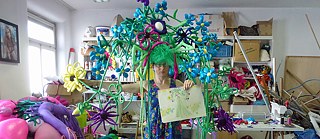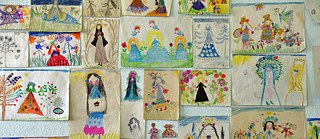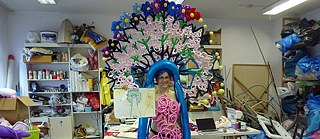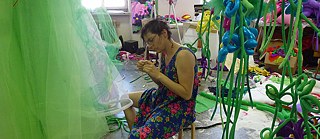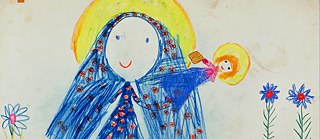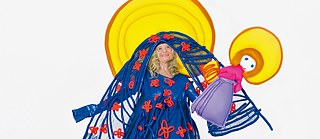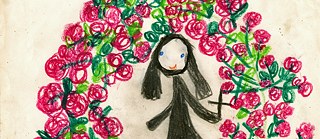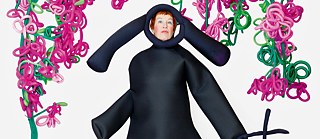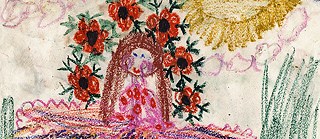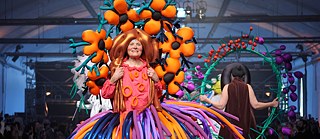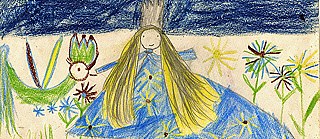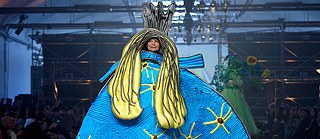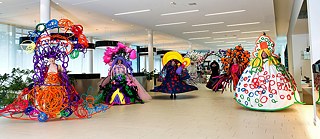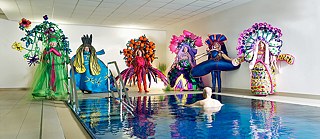The Image of Women under Scrutiny
The dangerous pink of Justyna Koeke
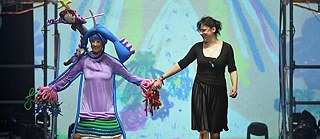
When it comes to femininity, the German-Polish artist, Justyna Koeke, goes against the flow. But why does she send old ladies dressed as fairy-tale princesses down the catwalk and lure sex-starved men via Tinder to take part in her photo sessions?
When her parents had to move house, Justyna Koeke came across a pile of children's drawings and paintings. She was appalled. For she and her five sisters had painted almost exclusively images of princesses and saints. “These are the roots, this is how girls are brought up,” says Koeke bitterly, “If a woman is not beautiful, she must at least be good.”
Justyna Koeke, born in Krakow in 1976, has long since moved away from these roots and no longer spends her days either in church or just being beautiful. The one thing she most definitely is not – is vain. This tall, dark-haired woman does not care very much about appearances, but prefers to win people over with her alert and uncomplicated manner. She is friendly, empathetic and always a live wire. After all, there is always something that has to be done. She whizzes through her huge studio, fishes a piece of fabric from a shelf here and stumbles there over some cushions with glued-on eyelashes that are then scattered all over the floor.
Justyna Koeke's work focuses on the way women are presented, depicted and dressed, with the aim of critically questioning the social expectations that women are subjected to. Of herself, she says that, artistically, she has “mega-feminist aspirations”. She has, however, also ascertained that there is “no consensus” in feminism, and her projects have also been criticised by feminists. For example, a nude calendar, in which women were photographed naked on construction sites. The feminist plaintive cry was heard – once again women taking their clothes off in front of the camera. Koeke, however, wanted to show that even a woman is “simply a body”, not necessarily sexy and provocative – as is so often the case in the advertising industry.
Most of the time, however, Justyna Koeke puts clothes on women. She works at the interface between fine arts and fashion. She, herself, describes her collections as “wearable sculptures” and shows them on models on a catwalk, as if they were in a fashion show. But her shows are decidedly artistic happenings - and any fashion designer in his right mind would tear his hair out when confronted by the sight of her studio in an old barracks in Ludwigsburg. The huge shelving units are crammed full, the floor is littered with pieces of fabric and peculiar objects made of cloth, like stuffed sausages, pink hearts or foam-plastic tarts. In one corner, a mattress from which the plastic was cut out, in another a hot glue gun.
AGAINST THE PINK WORLD OF GIRLS
Taking great strides, the artist climbs over the mountains of gold, glitter, foil, cords and crates. When she accidentally knocks a pot of coffee over, she quickly wipes up the brown brew with a piece of pink fabric; so to speak, trampling all over the one thing that is said to be the pride and joy of every little girl – pink with a lot of glitz and glamour.Koeke became aware in her childhood that she had less freedom as a girl. She grew up in a “very patriarchal family”, she says. Her father had been a despot, and, at an early age, she was infuriated by the unequal treatment of women and men in conservative Polish society. When she studied classical sculpture at the art academies of Krakow and Warsaw, she found the teaching, by “old men who simply passed on their style”, positively “antediluvian”. In 2000 it was love that brought her to Germany. While studying at the Staatliche Akademie der Bildenden Künste (State Academy of Fine Arts) in Stuttgart, she was, at last, given free rein and was now able to negotiate the issue of women's rights in a concrete artistic way. “It was very free, beautiful.” Today, she actually lectures herself at the Stuttgart Academy as a technical instructor in the Medienwerkstatt (Media Workshop).

A FUNDRAISING DRIVE FOR PROSTITUTES WHO WANT TO QUIT
At the moment she is focusing on the issue of prostitution. “One might think that we are an advanced society, but I was horrified at what is going on.” For example, she does not understand that even feminists support prostitution in Germany. “Everybody still seems to think it normal for men to pay money to use a woman's body.” Koeke wants to make it clear “that this is not okay” and has therefore invested money earned from her artistic projects in an apartment where prostitutes who want to quit the scene can live. In future, she will continue to deal with prostitution in her work.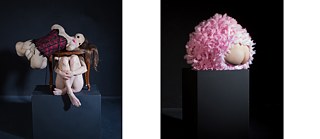
Once she hooked up for a project with a group of unknown men, whom she had met via the Tinder dating app. When they got to the forest, however, the men were not rewarded with the sex she had promised them, but the men were asked to photograph Koeke and her Finnish artist colleague, Mimosa Pale, outdoors. The men cooperated. “They were very insecure, but they got involved. It was a very nice experience, Justyna Koeke said, “so human”.
Justyna Koeke
was born in Kracow in 1976, studied sculpture in Krakow, Warsaw, Nuremberg and Stuttgart. She lives in Ludwigsburg and has been a lecturer in the fields of textile media and performance at the State Academy of Fine Arts in Stuttgart since 2006.
